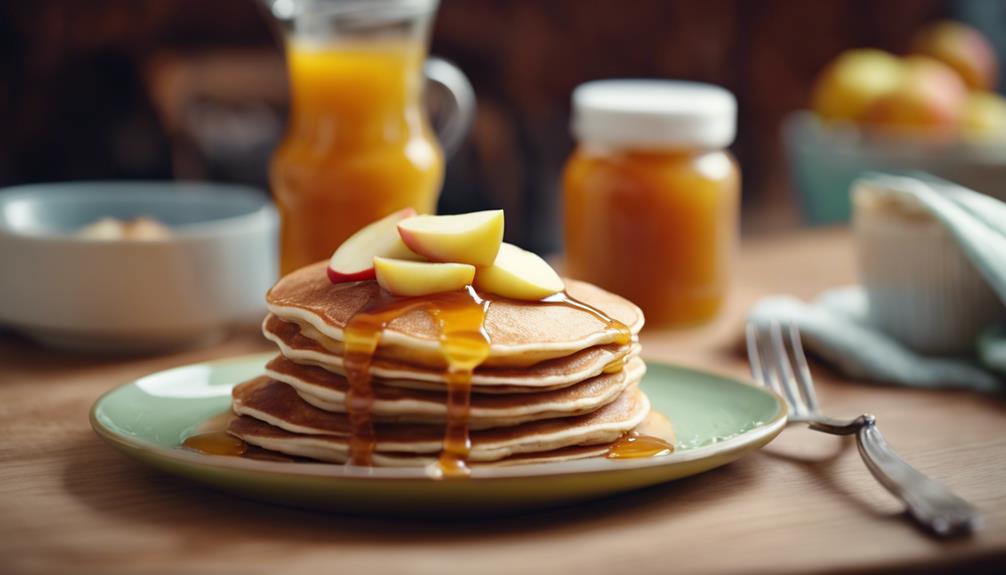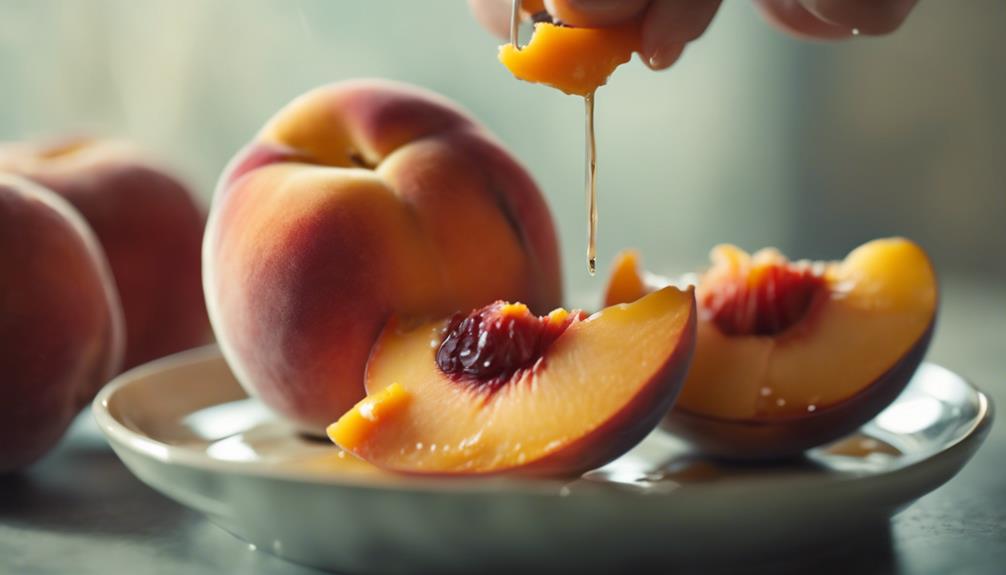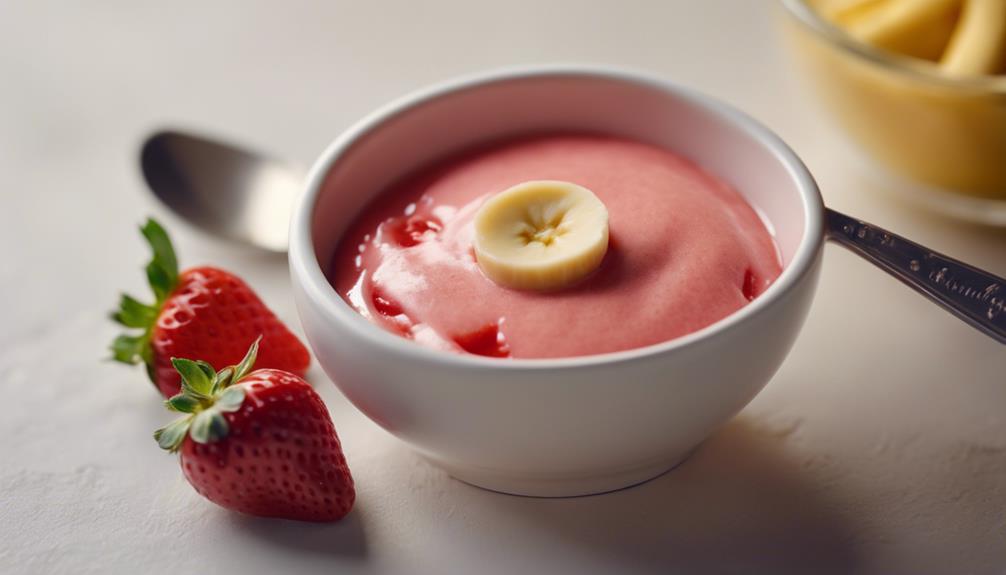For a nutritious breakfast, try apple pancakes for your baby. Packed with Vitamin C and antioxidants, they aid growth and bolster the immune system. The sweetness appeals to young taste buds. Mix oats, apple puree, milk, vanilla, and maple syrup for the batter. Cook on low heat until bubbles appear, then flip for a dense texture. Sub in almond milk, honey, or quick oats as needed. Freezing leftovers retains freshness for three months. Further details wait for those seeking more.
Key Takeaways
- Rich in Vitamin C for growth and immunity.
- Fiber-packed for digestive health.
- Natural sweetness from apples, appealing to young taste buds.
- Easily digestible for baby's delicate system.
- Customizable with dairy-free or sugar-free options.
Recipe Overview
Get prepared to immerse yourself in the details of this mouthwatering Apple Pancakes for Baby recipe. These pancakes are a fantastic source of Vitamin C, thanks to the inclusion of apple puree in the batter. Vitamin C is crucial for your baby's growth and development, supporting their immune system and overall health.
The combination of rolled oats, apple puree, and maple syrup creates a flavorful and nutritious pancake batter. These ingredients not only provide a delicious taste but also offer fiber, antioxidants, and natural sweetness.
The dense and filling texture of these pancakes guarantees that your little one stays satisfied and energized throughout the morning.
Essential Ingredients

To create the delicious and nutritious Apple Pancakes for Baby, you'll need essential ingredients like rolled oats, apple purée, milk, vanilla essence, and maple syrup. These ingredients have been carefully selected for their nutritional value and appeal to young children's taste buds.
Rolled oats provide a good source of fiber and energy, while apple purée adds natural sweetness and vitamins. Milk offers calcium for bone development, vanilla essence enhances flavor, and maple syrup adds a touch of sweetness.
The combination of these ingredients results in a wholesome and satisfying breakfast option for kids, ensuring they start their day with a nutritious meal. By choosing these specific ingredients, you can guarantee a delicious and balanced meal for your little one, promoting their growth and development.
Stay tuned to discover suitable substitutes for these essential ingredients in case of dietary restrictions or personal preferences.
Ingredient Substitutions
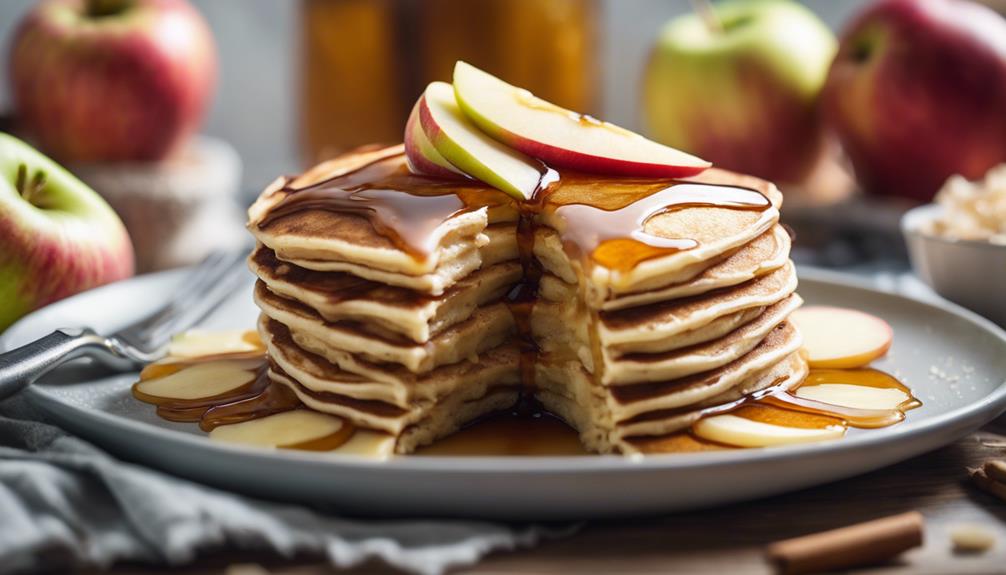
Consider incorporating various ingredient swaps to cater to dietary preferences or restrictions while maintaining the deliciousness and nutrition of the Apple Pancakes for Baby recipe.
If you're looking to make these pancakes dairy-free, opt for almond milk instead of regular milk.
The use of honey can be easily replaced with maple syrup as a sweetener in the apple pancake batter, offering a different flavor profile.
Substituting quick-cook oats for rolled oats can save you time without compromising on the texture of the pancakes.
For a convenient swap, consider using unsweetened applesauce in lieu of apple purée to achieve a similar consistency and taste.
Additionally, if you prefer a more spiced flavor, cinnamon can be used instead of vanilla essence to infuse the pancakes with a warm and aromatic twist.
These ingredient substitutions provide flexibility to tailor the recipe to your needs while keeping the essence of these delightful Apple Pancakes for Baby intact.
Preparation Steps

Incorporate the prepared batter into the following simple steps to cook and serve delicious Apple Pancakes for Baby.
To begin, blend rolled oats, apple purée, milk, vanilla essence, and maple syrup to create a thick batter suitable for your baby's breakfast. Once the batter is ready, heat a greased pan over low heat. Pour the batter onto the pan and cook until bubbles start to form on the surface. Gently flip the pancake and cook the other side until it is golden brown.
For the best results, ensure thorough cooking to achieve a dense and filling texture perfect for your little one. If needed, you can substitute ingredients such as dairy-free milk, honey, or quick-cook oats to accommodate any dietary needs or personal preferences.
For convenience, consider freezing any leftover pancakes. They can be stored for up to 3 months and easily reheated for quick and hassle-free breakfast options.
| Preparation Steps | Details | Tips |
|---|---|---|
| Blend the batter | Oats, apple purée, milk, vanilla, maple syrup | Maintain a smooth consistency |
| Cook on low heat | Until bubbles form, then flip | Use a non-stick pan for easy flipping |
| Ensure thorough cooking | Achieve a dense texture | Check with a toothpick for doneness |
Cooking Tips

For smoother consistency, blend the batter using a vented blender to avoid lumps when cooking baby apple pancakes.
When cooking the pancakes, opt for low heat to prevent quick browning, ensuring even cooking throughout. This gentle approach helps maintain the delicate flavors and textures for your little one's enjoyment.
If you find yourself with extra pancakes, consider freezing them in an airtight container for up to 3 months to preserve their freshness.
To cater to specific dietary needs or allergies, feel free to substitute ingredients like dairy-free milk, honey, or quick-cook oats as necessary.
Additionally, in the event that you run out of baking powder, baking soda can be a suitable replacement. However, be mindful of potential taste and texture adjustments that may result from this substitution.
Freezing and Storage Guide

To maintain the freshness and taste of baby apple pancakes, freezing them in an airtight container is an important option. Freezing extends the shelf life of the pancakes, ensuring their flavors remain intact for future consumption.
Properly stored in the freezer, these delectable treats can maintain their quality for 2-3 months. Adhering to recommended storage guidelines is vital to prevent wastage and guarantee that the pancakes are always ready to serve at a moment's notice.
Whether stored in the fridge or freezer, employing correct storage techniques is necessary to retain the deliciousness of these sweet breakfast delights. By following these simple steps, you can enjoy the convenience of having baby apple pancakes readily available whenever you desire a quick and tasty meal for your little one.
Adjusting the Recipe
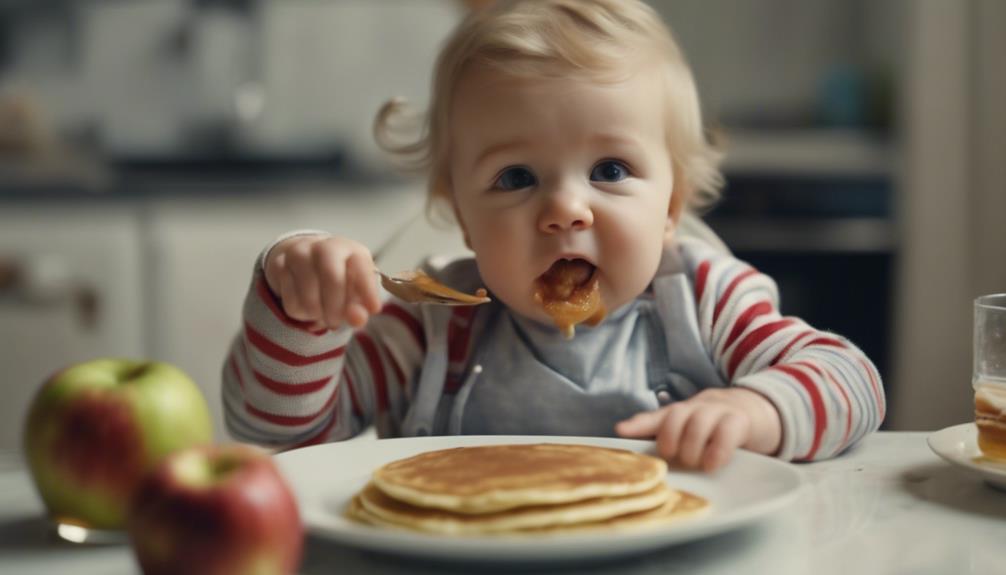
When adjusting the recipe for apple pancakes, consider ingredient substitutions, texture, and consistency, and cooking techniques.
Substituting applesauce for apple purée can simplify the recipe, but verify to check labels for added sugars.
Personal taste preferences will guide how much applesauce to use, and experimenting with banana may alter the pancake's texture.
Ingredient Substitutions
Consider incorporating applesauce as a convenient and flavorful alternative to apple puree in the baby pancake recipe. When substituting, be mindful of the added sugar content in some applesauce brands. Adjust the amount of applesauce according to your taste preferences to achieve the desired flavor profile.
If you opt to use banana instead of applesauce, keep in mind that this may result in denser pancakes. Ensure thorough cooking to make sure the pancakes are fully cooked in the center. Remember that denser pancakes are typical for this recipe, so focus on maintaining proper heat control to prevent burning while cooking.
Experiment with different ingredient substitutions to personalize the recipe to your liking, but always be cautious of how these changes may impact the overall texture and taste of the final dish.
Texture and Consistency
Enhance the texture of your baby pancakes by adjusting the amount of apple purée or applesauce in the recipe for a customized consistency that suits your baby's preferences.
Increasing the apple purée can result in moister and softer pancakes, which are ideal for younger babies who are just starting on solid foods.
On the other hand, decreasing the amount of apple purée can lead to firmer pancakes, more suitable for older babies who are moving towards slightly more solid textures.
It's essential to experiment with different textures to find what works best for your baby's age and eating abilities.
By customizing the consistency of the pancakes, you can cater to your baby's preferences and developmental stage, ensuring a pleasant eating experience.
Remember that each baby is unique, and adjusting the texture of the pancakes can help in providing a meal that's both enjoyable and appropriate for your little one's needs.
Cooking Techniques
To alter the texture and flavor of your baby's apple pancakes, consider using applesauce instead of apple purée in the recipe. Applesauce can provide a different consistency and taste profile, adding a unique twist to the traditional pancake recipe.
When selecting applesauce, choose unsweetened versions to avoid unnecessary added sugars commonly found in commercial brands. Experiment with varying amounts of applesauce to customize the flavor intensity and sweetness level to suit your baby's preferences.
Be cautious when substituting applesauce with banana, as this may result in denser pancakes. Thorough cooking to achieve the desired consistency if opting for this substitution is important. Proper heat adjustment on the pan is essential for preventing burning and achieving optimal cooking results when preparing apple pancakes for your little one.
Gluten Content Facts

When considering gluten content facts, it's crucial to highlight the connection between oats and gluten. While oats are naturally gluten-free, labeling laws in New Zealand differ, affecting their classification.
For individuals with Celiac disease, organizations like the New Zealand Coeliac Society support the safety of oats but recommend caution to avoid cross-contamination.
Oats and Gluten Connection
Oats, being naturally gluten-free, are a safe choice for individuals with Celiac disease, despite labeling variations across different countries. In New Zealand, oats aren't classified as gluten-free according to labeling laws, although they inherently lack gluten. This discrepancy arises due to differing regulations on gluten-free labeling globally.
Despite this, institutions like the NZ Coeliac Society and Food Labeling Standards affirm the suitability of oats for those with gluten sensitivities. Oats contain a low gluten content, making them generally well-tolerated by individuals with Celiac disease. Their gluten levels are typically insufficient to trigger adverse reactions in most cases. As a result, individuals with gluten sensitivities can usually include oats in their diet without experiencing negative consequences.
It's essential for those with Celiac disease to be aware of the gluten content in oats and the labeling regulations in their respective regions to make informed dietary choices.
Coeliac Disease Considerations
Understanding the gluten content of oat products is essential for individuals with Celiac disease to make informed dietary choices.
While oats are naturally gluten-free, it's important to note that New Zealand labeling laws don't categorize oats as gluten-free. However, both the NZ Coeliac Society and Food Labeling Standards advocate for the safety of oats for those with Celiac disease.
It's worth highlighting that gluten-free labeling regulations can vary between countries, which may impact how consumers perceive the gluten content of oat products.
Despite oats being generally safe for consumption by individuals with Celiac disease, there's a risk of potential cross-contamination. Therefore, it's vital for those with gluten sensitivities to diligently check labels and verify the gluten content of oat products before incorporating them into their diet.
Nutritional Information
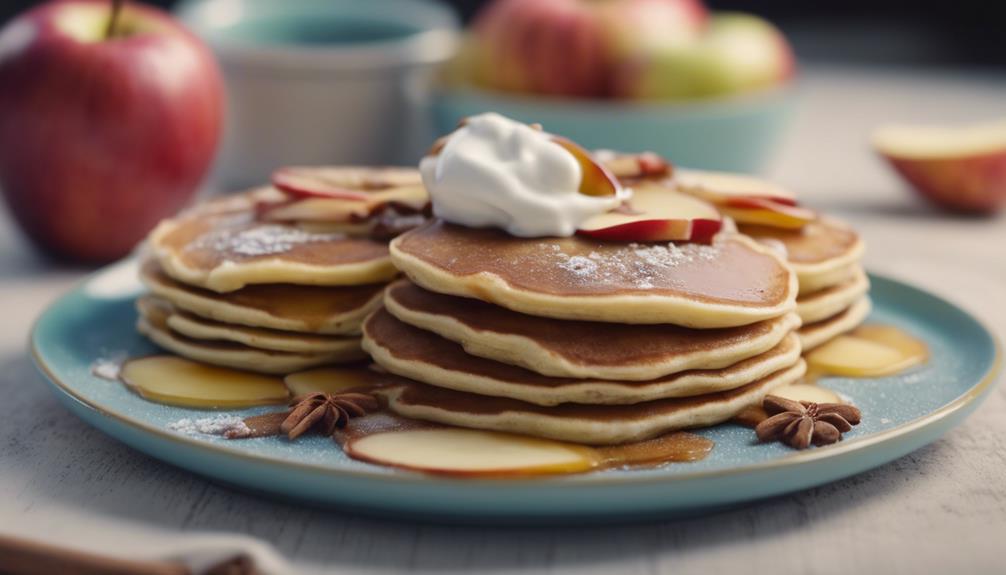
For a quick overview of the nutritional benefits, take a closer look at the breakdown of key ingredients in these apple pancakes for your baby.
These baby pancakes, crafted with apple and oats, offer a wholesome breakfast option that caters to various dietary restrictions. Being wheat-free, egg-free, and dairy-free, they're suitable for kids with specific dietary needs.
The combination of oats and apple purée not only provides a dense and filling texture but also guarantees sustained energy levels, making them ideal for active children.
Additionally, the flexibility to substitute ingredients like dairy-free milk or honey allows for customization based on preferences or allergies.
These pancakes are a nutritious choice for your little one, offering a balance of flavors and textures while meeting essential dietary requirements.
Serving Suggestions
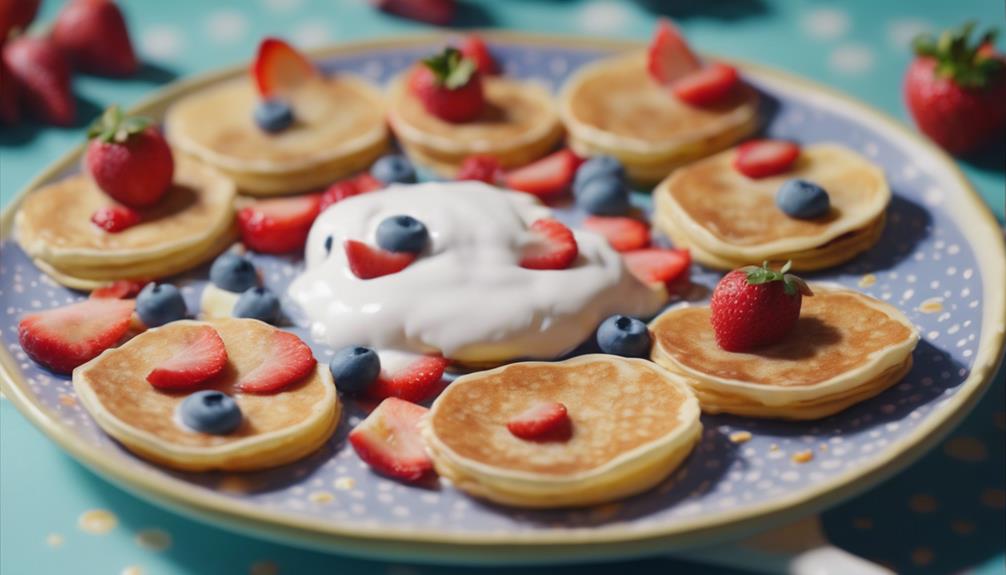
Enhance your baby's apple pancakes with a dollop of dairy-free yogurt or a drizzle of honey for a touch of sweetness.
Complement the pancakes with fresh fruit slices or a small handful of nuts to create a balanced and nutritious breakfast option.
For a savory twist, consider topping the pancakes with a sprinkle of cinnamon or a light dusting of powdered sugar.
Take it up a notch by crafting a mini pancake stack, layering the apple pancakes with a spread of nut butter between each layer for added flavor and texture.
To make mealtime more engaging, cut the pancakes into bite-sized pieces and serve them with a side of pureed fruit for dipping.
This interactive approach can make breakfast more enjoyable for your little one while also introducing different tastes and textures.
Frequently Asked Questions
Can Babies Eat Pancakes and Syrup?
Yes, babies can enjoy pancakes and syrup. It's important to monitor sugar content by choosing healthier options like maple syrup or honey. Limit syrup and opt for homemade pancakes for better control over ingredients.
Can Pancakes Be Eaten as Dessert?
Pancakes can indeed be enjoyed as dessert! Elevate them with sweet toppings like fruit compote or chocolate sauce. Experiment with nuts, seeds, or flavored syrups for a decadent twist. Add ice cream or whipped cream for extra indulgence.
How to Prepare Apples for a 9 Month Old?
To prepare apples for a 9-month-old, peel, core, and dice them into small pieces to prevent choking. Cook until soft, then mash for safe eating. Avoid adding sugar. Introduce gradually, watching for allergies or digestive issues.
How to Serve Cooked Apple to Baby?
To serve cooked apple to your baby, soften it by steaming, baking, or boiling. Remember to peel and remove seeds before mashing or pureeing. Mix with other baby foods or offer alone. Introduce gradually to watch for allergies.
Conclusion
To sum up, apple pancakes for baby are a delightful breakfast option that combines the sweetness of fruit with the comfort of pancakes.
They're a perfect balance of flavors, providing a tasty and nutritious meal for your little one.
With a soft texture and delicious taste, these pancakes are sure to be a hit at the breakfast table.
So why not treat your baby to a delicious meal that's both satisfying and wholesome?
